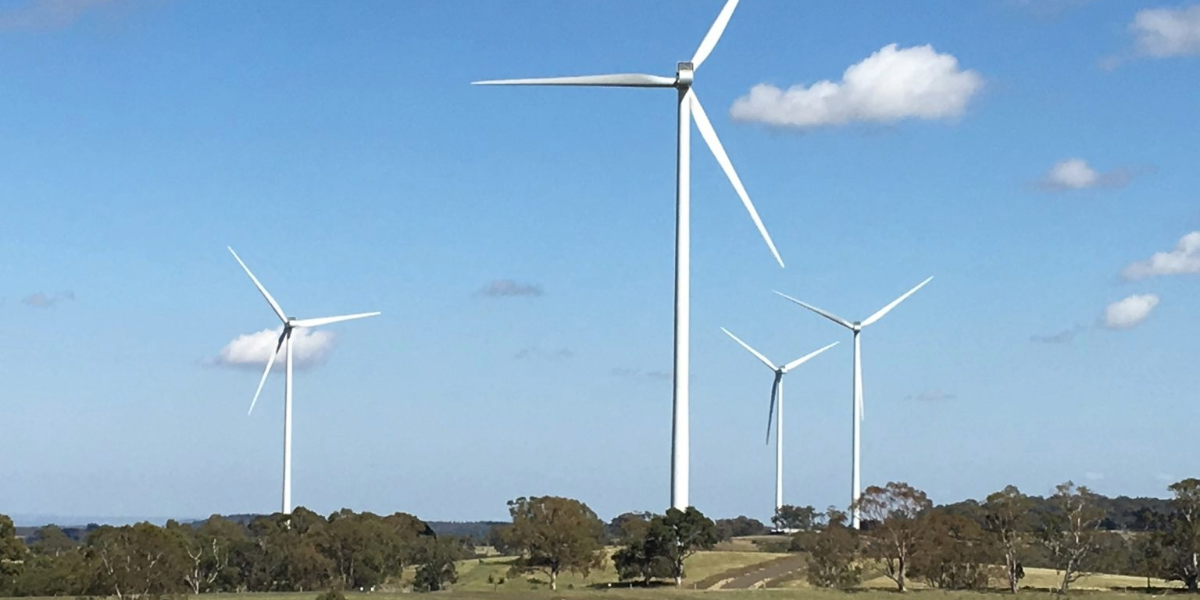Renewables in agriculture are gaining momentum across the nation, including in the New England, as Australia pushes to reach its net-zero emissions target by 2050.
Australia’s energy market operator has declared renewables as the most cost-effective way of reaching net-zero targets in the grid, but just how much of the load will be carried by the farming sector remains unclear.
Across the nation, farmers are already doing their bit to reduce their carbon footprint.
“Anecdotally, we have seen a huge increase in farmers seeking renewables projects as farmers seek to increase the productivity of their farms,” Farmers for Climate Action’s Natalie Collard told AAP.
“Renewables offer drought-proof income, and drought-proof income keeps farms going through the toughest of times.”
In regional Victoria, a hot air balloon sails over a sheep farm where animals munch on grass beneath 373,000 solar panels.
The Lee family has farmed at Glenrowan West for 150 years, but for the past three years they’ve also added solar to the mix.
A German-based company leases the land from the Lees and maintains the solar panels, which run alongside the sheep farming operation.
“The lessee basically runs it just as another paddock, the sheep go in just as they would under any other farming operation,” Gayle Lee said.
“We haven’t found there to be any noticeable loss of production.”
On the other side of the country at Manjimup, south of Perth, avocado farmer Rod Duncan is off the electricity grid.
High above the avocado trees, he’s trialling a new electric cherry picker for his annual thousand-tonne harvest, and is working to electrify the entire fleet with lithium batteries to be powered by solar.
“By being green, we’ll save fuel. It’s also going to be quieter, less fumes in the orchard, better for the workers,” Mr Duncan said.
Mr Duncan, who will save up to $50,000 a year in fuel, had been held back by technology and a lack of capital injection.
Supermarket giant Coles has helped with the latter, providing an almost half a million dollar sustainability grant to fund the fleet.
“Otherwise it would be a very slow transition to gradually try to become more electric,” Mr Duncan said.
A lack of funds is constraining some producers, according to RE-Alliance – a group working for the past decade with regional communities hosting large scale renewables.
The group’s national director Andrew Bray says one of the biggest barriers facing farmers considering the switch is the high up-front cost, and knowing which path to choose.
“There is a lack of regional expertise to assist a farmer’s decision-making when determining the business case for on-farm renewable energy solutions,” Mr Bray said.
“It can be really hard to work out what type of technology you need and who is the trusted local supplier to install it, or whether hosting large-scale infrastructure on your property is the right move for the family business – let alone what you need to consider when negotiating with developers.”
The group wants local energy hubs set up in renewable energy zones across Australia to help plug the information gap.
New England farmer Rachel Rummery says more information would have helped on her family’s journey to host wind turbines on their cattle farm near Bendemeer.
“It takes time to work through, what would be the impacts on my business and what would be the benefits,” she said.
The Rummerys are among 13 farmers hoping to earn an income from one of the many planned wind and solar farms in the New England Renewable Energy Zone.
The project is still at an environmental planning stage.
“There will be no impact on my grazing agriculture I can foresee from having wind towers there, they’ll just fit in with what we do,” she said.
For her husband Tom Rummery, part of the appeal of hosting the turbines is knowing they will be decommissioned at the end of the project, and the proposal that millions of dollars will be poured into the community over the next 30 years.
“I see that it’s an absolute game-changer for a small town,” he said.
But for all of the enthusiasm for renewables in agriculture, there is also plenty of opposition.
“We’re seeing tens of thousands of square kilometers being … ruined for agricultural production,” NSW Farmers’ President Xavier Martin said.
“At the moment, we’re seeing neighbour against neighbour, family member against family member, community against community. It’s just so dysfunctional.”
Australia is already getting 40 per cent of its electricity from renewables, with AEMO’s roadmap planning to pump that to 82 per cent by 2030.
But there is no data on how much of that comes from agriculture or what’s in store for the future.
In July, data scientists from the Australian Bureau of Agricultural and Resource Economics and Sciences will head into the field to start measuring.
Karin Stark, who will host the annual Renewables in Agriculture conference in Toowoomba next week, says consultation is key to farmers playing a “critical role” in the renewables transition and keeping everyone happy.
“Some states are better than others in terms of going out really early to the community to consult on where these new transmission lines could go and where these renewable energy zones which are replacing coal-fired power stations should be placed.”
Something going on in your part of the region you think people should know about? Send us a news tip or email newsdesk@netimes.com.au.

